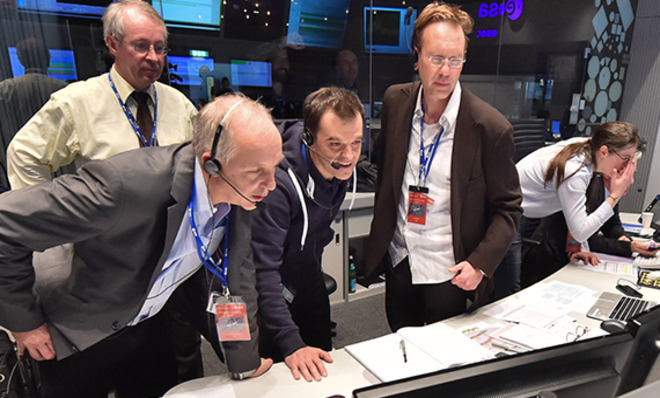The 5 biggest scientific breakthroughs of 2014
This year we found new hope for the paralyzed, touched down on a comet, and discovered the biggest dinosaur yet

New hope for the paralyzed
A pioneering surgical procedure enabled a paralyzed man to walk again. Bulgarian firefighter Darek Fidyka, 40, was paralyzed from the chest down when a knife attack severed his spinal cord. Doctors bridged the tear with nerve tissues from his ankle and injected the area with cells from his nasal cavity that help the sense of smell return after nasal damage. The theory was that the cells' regenerative function would help the "bridge" reconnect the spinal cord. Within five months, Fidyka regained some feeling in his legs; two years later, he could walk. "It's like you were born again," says Fidyka.
Stem cell breakthroughs
The Week
Escape your echo chamber. Get the facts behind the news, plus analysis from multiple perspectives.

Sign up for The Week's Free Newsletters
From our morning news briefing to a weekly Good News Newsletter, get the best of The Week delivered directly to your inbox.
From our morning news briefing to a weekly Good News Newsletter, get the best of The Week delivered directly to your inbox.
It was a huge year for stem cell technology. In August, scientists revealed that infusing stem cells into the brains of stroke victims dramatically improved their recovery. Severe strokes usually result in death or serious disability, but all the patients treated with stem cells showed signs of recovery after six months. A second breakthrough came in October, when Harvard University scientists cured type 1 diabetes in mice by injecting them with insulin-secreting cells derived from stem cells. If the procedure works in humans, people with the disorder could potentially be cured with a single injection. "We are now just one pre-clinical step away from the finish line," says lead researcher Douglas Melton.
Touchdown on a comet
For millennia, mankind has wondered at the appearance of comets in the night sky. This year, earthlings finally reached up and touched one. A European Space Agency probe landed on comet 67P/Churyumov–Gerasimenko, an icy rock streaking through the solar system at 41,000 mph 311 million miles from Earth. Launched from the ESA's Rosetta spacecraft, which began orbiting the comet in August, the refrigerator-size probe drilled into the space rock's surface to examine its chemical makeup. Composed of ice, dust, rocks, and other organic materials, comets are leftovers from the formation of the solar system 4.5 billion years ago and may have played a crucial role in the development of life on Earth.
The biggest dinosaur found yet
A free daily email with the biggest news stories of the day – and the best features from TheWeek.com
This September, fossil hunters in Patagonia announced they had unearthed the remains of the largest dinosaur ever to walk the Earth. Paleontologists estimate that the herbivorous Dreadnoughtus schrani was as long as a basketball court and weighed nearly 65 tons, equivalent to a dozen African elephants. The creature's neck vertebrae were almost a meter wide, while the bones at the end of its 9-meter tail appear to have been covered with powerful muscles. "It's time the herbivores get their due," says paleontologist Kenneth Lacovara.
Preserving donated hearts
New methods for treating donated organs promise to shorten the long wait times endured by patients in need of transplants. Doctors at St. Vincent's Hospital in Sydney were able to revive a heart that had stopped beating by placing it in a machine that bathed the organ in warm, oxygenated blood and other nutrients, preventing deterioration of its muscle cells. Similar methods were also used to treat livers, lungs, and kidneys before transplantation. "This breakthrough represents a major inroad to reducing the shortage of donor organs," said Peter MacDonald, head of St. Vincent's heart transplant unit. Some 2,000 patients receive heart transplants in the U.S. every year. Doctors hope this new method will increase that figure 30 percent.
-
 NASA discovered 26 microbes in their cleanrooms
NASA discovered 26 microbes in their cleanroomsUnder the radar The bacteria could contaminate space
-
 The elite falcon trade in the Middle East
The elite falcon trade in the Middle EastUnder the Radar Popularity of the birds of prey has been ‘soaring’ despite doubts over the legality of sourcing and concerns for animal welfare
-
 A running list of the international figures Donald Trump has pardoned
A running list of the international figures Donald Trump has pardonedin depth The president has grown bolder in flexing executive clemency powers beyond national borders